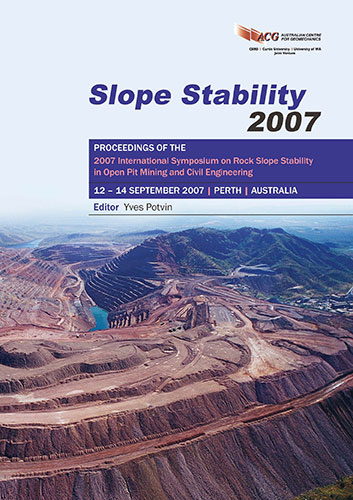Establishing Slope Design Criteria at Batu Hijau - A Case Study

|
Authors: Leech, SJ Paper is not available for download Contact Us |
DOI https://doi.org/10.36487/ACG_repo/708_8
Cite As:
Leech, SJ 2007, 'Establishing Slope Design Criteria at Batu Hijau - A Case Study', in Y Potvin (ed.), Slope Stability 2007: Proceedings of the 2007 International Symposium on Rock Slope Stability in Open Pit Mining and Civil Engineering, Australian Centre for Geomechanics, Perth, pp. 143-155, https://doi.org/10.36487/ACG_repo/708_8
Abstract:
The establishment of appropriate open pit slope design criteria will evolve throughout the life of the mine, and is based primarily on an ever increasing understanding of the geotechnical conditions, the historical performance of the slopes (including interim phase pit slopes), and the level of onsite geotechnical and mine engineering expertise. Other ‘external’ factors (e.g. ore blending requirements, prevailing metal price, mill throughput requirements, corporate goals and expectations, government policy/restrictions, etc) can also have a significant impact, particularly over the shorter term. Therefore, it is essential to implement an extensive peer review process, incorporating expertise from various disciplines (including mine engineering, geotechnical engineering, mine operations, etc.), sourced both in-house and externally. With the limited design tools that are available to assist in the optimisation of large (plus 500 m) open pit slopes, the basis for the generation of appropriate slope design criteria comes in large part from rational assessment of historical slope performance, combined with an ever increasing level of reliability of geotechnical models, and the implementation of continuously improving operating practices. Safety is a cardinal component of the slope design process, but an understanding of the level of risk the owners and stakeholders are willing to accept, with respect to potential significant production losses, is also critical.
© Copyright 2025, Australian Centre for Geomechanics (ACG), The University of Western Australia. All rights reserved.
View copyright/legal information
Please direct any queries or error reports to repository-acg@uwa.edu.au
View copyright/legal information
Please direct any queries or error reports to repository-acg@uwa.edu.au